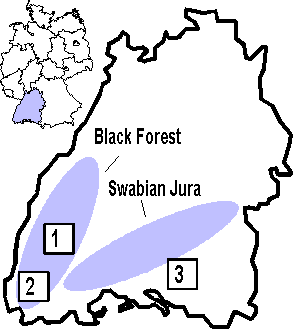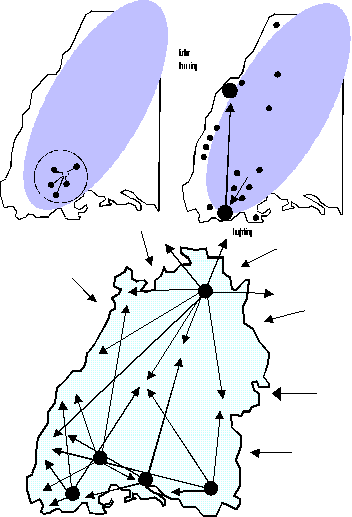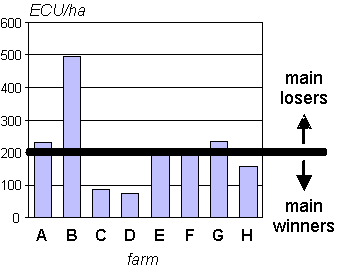 The James Hutton Institute
The James Hutton Institute
This page is no longer updated. The Macaulay Land Use Research Institute joined forces with SCRI on 1 April 2011 to create The James Hutton Institute.
2nd LSIRD Conference on Livestock production in the European LFAs, Bray, Ireland. Dec '98
Rainer Luick / ILN-Singen, Germany
1. Introduction

Illustration 1: Location of case study areas in Baden-Württemberg/Germany
( 1 = Central Black Forest, 2 = Southern Black Forest,
3 = "Federsee"-Basin).
In many mountainous LFA´s in Germany, dairy production has been of primary economic importance until now. There is, however, considerable doubt as to whether dairy regimes which operate under harsh environmental conditions can possibly have an optimistic future - at least when viewed from the stand-point of main-stream agricultural economics. This assumption is supported by the AGENDA 2000 proposals, which suggest that future CAP measures should be developed away from price support mechanisms into support systems which focus on direct farm payments. Such schemes will probably be based on area payments and additionally on subsidiarity in order to share costs. Taking into account falling milk prices and declining price support, payments to maintain dairy production in LFA´s will have to be much higher than they are at present. It can be assumed that this money will not be available and it is expected, therefore, that grassland dominated LFA´s will be forced increasingly to develop into regions characterised by extensive livestock keeping systems. The main reason why agricultural activities in less favoured areas should be continued, instead of forestry, is because agriculture is a fundamental means of maintaining social, cultural and ecological conditions. Some problems, possibilities and limits of extensive livestock systems as a new way of farming are presented for case study areas a) with pre-existing low intensity livestock systems b) where the implementation of such systems could be a future alternative, and c) where even low intensity livestock systems have little future (illustration 1).
The report focuses on results of recent research work in less favoured areas in the Federal State of Baden-Württemberg emphasising the possibilities and constraints of low intensity livestock systems.
1. Central Black Forest

Illustration 2 a, b and c: Top left shows the "Schmidt-Märkte" marketing concept for extensive cattle in the southern part of the Black Forest/Baden-Württemberg which developed very successfully during the last years (production, processing and marketing at good prices within close distances). Top right shows the altered situation of this project due to the EU-labelling regulation (processing out of the region, increase of market force, fall of prices). The lower map illustrates, that more and more production initiatives for quality and/or extensive cattle in less favoured areas are competing with each other on the same market.
Since the middle of this century this region has developed away from mixed agriculture into a more or less entirely grassland dominated agricultural system with mostly dairy production. Due to falling milk prices but increasing production costs, this LFA is faced with dramatic structural changes in the medium term. The EU policy for economic dairy production allows farm sizes with a minimum of 80 cows and at least 8,000 kg milk per cow and year. In contrast, the Black Forest region has a production capacity of a maximum of 4,000 kg per cow/ year on the best land. The future development of this landscape alongside the CAP can be described as follows: afforestation of low productive fields, continuing dairy at the most suitable locations, high import of concentrates, pollution problems and further decline of ecological values.
The official agricultural guidance does not see any alternatives although (some) farmers have started the discussion to develop new strategies such as, for example, extensive grazing systems with suckler cows. The reasons why this way is not undertaken naturally are as follows: lack of official interest in this production system; the existing infrastructure is not suitable; farmers do not co-operate in production and marketing; lack of understanding and programmes to support extensive beef production; lack of existing marketing structures and strategies.
2. Southern Black Forest
In the southern Black Forest with its small scale farming structure and vast common grazings, extensive cattle systems with suckler cows are already of considerable importance. This change of agriculture has taken place during the last decade because of closures of small, part-time dairy farms. The situation in the southern part of the Black Forest shows the problems of less favoured areas which are in a transitional situation, developing new ways of farming. LFAs which often are regions with few agricultural products but produced in large quantities (milk and/or meat) have the following problems: The marketing can not just be done in the "neighbourhood". High quality premium products can be sold at high prices because of their linkage to unique environmental and ecological commodities. If the market is far away from the production area, this incentive is difficult to deal with. Illustration 2 shows that many extensive beef production initiatives already operate on the same market. Although the demand for extensive premium beef is increasing, all marketing strategies have to focus on the displacement of ordinary beef products as well as on the displacement of competing high quality products.
3. "Federsee"-Basin in Upper Swabia
The fen area of the Federsee-basin with a size of about ca. 10.000 hectares belongs to the ecologically and archaeologically (neolithic settlements) most valuable regions in Central Europe. Of great importance are wet grasslands and extended reedbeds. Although considered as an LFA, the basin is surrounded by fairly productive arable land. Since the agricultural area of each community is only partly situated in the fen zone, the agricultural development at present can be described as follows: Declining interest in the use of low productive grassland; collapsing dairy production; the remaining competitive dairy farms do not rely any more on grassland; since crop silage and concentrates more and more replace hay and green fodder; pig production is increasing, and grassland is used for slurry deposition. There have been discussions in the region about future perspectives of the use of the wet grassland, highlighting the possibility of extensive grazing systems. But the constraints are that farmers have alternatives -due to their productive arable sector- and do not wish to invest in an uncertain or new production system. The second point that has to be stressed is that grazing systems located only in the fen area are not possible, because of the problematic site conditions (high groundwater level). Grazings systems would also need areas outside the peat zones, which, at the moment are not available. The consequences of this scenario are that great parts of the basin will be abandoned in the near future with resulting ecological succession to scrubland. If money is available, the second alternative is that the landscape is kept open by means of conservation management. This latter raises the question of what to do with the resulting biomass?

Illustration 3: The compensation of a price loss of 0.05 ECU per kg milk by means of average area payments would have main loser and main winner effects. Losers will be intensive dairy farms, winners will be (theoretically) extensive farms.
4. Agenda 2000 implications
Since the income of farmers in LFAs already depends up to 100 per cent (shepherds and high mountain farms) on subsidies, premiums or other financial support measures, the discussion about the effects of the AGENDA 2000 reform is very vivid. One objective calls for direct payments to be linked to area payment schemes (payments which are eligible with the green box). On-farm case studies show that area payment schemes can have main-winner and main-loser effects (illustration 3). Production costs (dairy and/or beef) in the same area and over small distances can have an extreme range, which raises the question about the scale at which area payments can be calculated. Area payment-based agricultural support programmes such as the MEKA scheme in Baden-Württemberg show that economic returns are stimulated even in fairly unproductive regions. Land mobility as a fundamental factor for new structures is therefore very little.
Address:
Dr. Rainer Luick
Institut für Landschaftsökologie und Naturschutz (ILN) Singen
Mühlenstr. 19
78224 Singen/Htwl.
Tel. ++49-(0)-7731-9962-0
Fax ++49-(0)-7731-9962-0
e-mail ILN-Singen@t-online.de
References
LUICK, R. (1994): Modelle zur extensiven Rinderbeweidung als Folgenutzung von Grünland.-Landschaftspflege Quo vadis (II), Kolloquium Landesanstalt für Umweltschutz Bad.-Württ. am 17.11.94 in Ettlingen, 57-68, Karlsruhe.
LUICK, R. (1995): Ein Modellprojekt zur extensiven Beweidung von Feuchtgrünland. In: Wieder beweiden? - Möglichkeiten und Grenzen der Beweidung als Maßnahme des Naturschutzes und der Landschaftspflege.- Beiträge der Akademie für Natur- und Umweltschutz Bad.-Württ. 18, 77-86, Stuttgart.
LUICK, R. (1995): Studies of pasture management and floral richness in Germany. In: MC. CRACKEN, D. & BIGNAL, E. (ed.): Farming on the edge, the nature of traditional farmland in Europe.- Proceedings of the fourth Europeen Forum on Nature Conservation and Pastoralism 2-4 Nov. 1994 Trujillo, Spain, 141-146, Joint Nature Conservation Committee (JNCC), Peterborough, UK.
LUICK, R. (1996): Extensive Rinderweiden - Gemeinsame Chancen für Natur, Landschaft und Landwirtschft.- Z. Naturschutz und Landschaftsplanung 2/96, 37-45.
LUICK, R. (1996): Extensivweiden und ihre Geschichte in Deutschland.- Ber. Inst. Landschafts und Pflanzenökologie Univ. Hohenheim H. 5, 31-50, Stuttgart-Hohenheim.
LUICK, R. (1996): High nature value cattle farming in the Black Forest - a case study for the impact of EU-agricultural policy on less favoured areas in Germany.- Proceedings of the Expert-Hearing "The Common Agricultural Policy and Environmental Practices", European Forum on Nature Conservation and Pastoralism (EFNCP) and WWF (European Policy Office), 29th January 1996 Brussels, 19-30.
LUICK, R. (1996): Extensivweiden und ihre Geschichte in Deutschland.- Ber. Inst. Landschafts- und Pflanzenökologie Univ. Hohenheim H. 5, 31-50, Stuttgart-Hohenheim.
LUICK, R. (1996): Der Einfluß der (EU-)Agrarpolitik auf strukturell benachteiligte Regionen in Deutschland - Die Fallstudie Schwarzwald.- Artenschutzreport 6/96, 40-46.
LUICK, R. & WESTPHAL, J. (1997): Naturschutz durch Nutzung: Mutterkuhhaltung im westlichen Bodenseegebiet - Erfahrungen, Bewertungen, Probleme und Erwartungen.- Kritischer Agrarbericht 1997, 227-236, Rheda-Wiedenbrück.
LUICK, R. (1997): Kulturlandschaftspflege mit Nutztieren - Erfahrungen privater Projektträger.- Schriftenr. Angewandter Natursch. Bd. 13 (Hrsg: Naturlandstiftung Hessen e.V.), 144-155, Lich.
LUICK, R. (1997): Mutterkuhhaltung in Baden-Württemberg - Ergebnisse einer agrar-soziologischen Untersuchung.- Ber. Inst. Landschafts- und Pflanzenökologie Univ. Hohenheim H. 6, Stuttgart-Hohenheim, 137-158.
JILG, T. & LUICK, R. (1997): Extensivweide braucht große Fläche - Futterwert des Weidefutters auf Grünland bei extensiver Beweidung mit leichten Rinderrassen.- Fleischrinder Journal 3/97, 12-15.
JILG, T. & LUICK, R. (1997): Futterwert des Weidefutter - Extensive Beweidung von Grünlandbiotopen mit leichten Rinderrrassen.- Landinfo 8/97, 13-16.
LUICK, R. (1997): Situation und Perspektiven des Extensivgrünlandes in Südwestdeutschland.- Schriftenr. f. Landschaftspflege u. Naturschutz 54 (Hrsg.: Bundesamt für Naturschutz), 25-54, Landwirtschaftsverlag, Hiltrup.
LUICK, R. (1998): Extensive pasture systems in Germany - Realising the value of environmental sustainability.- Proceedings of the conference "livestock systems in rural development in disadvantaged areas", Nafplio-Greece 22-26 January 1997 (in print).